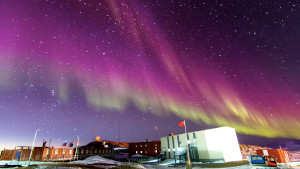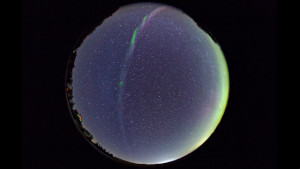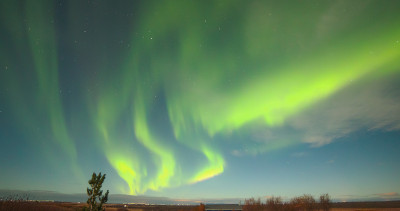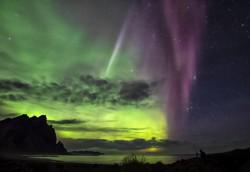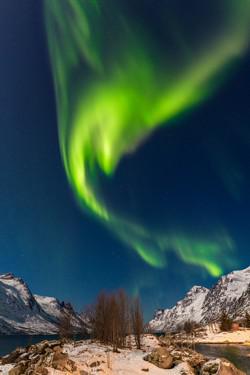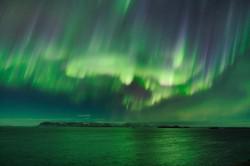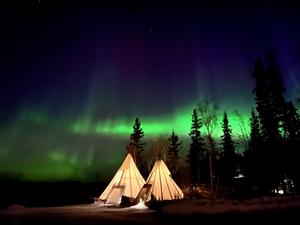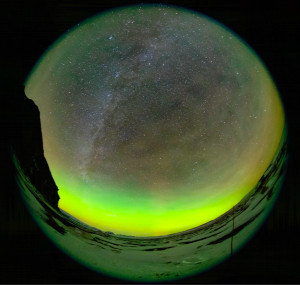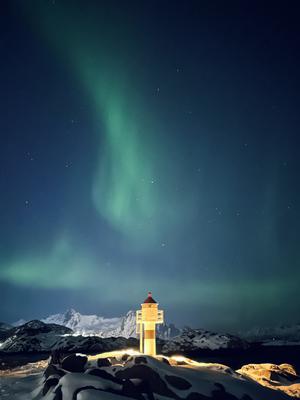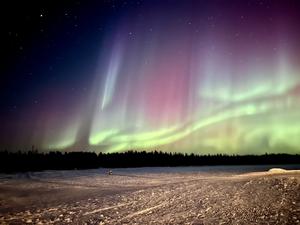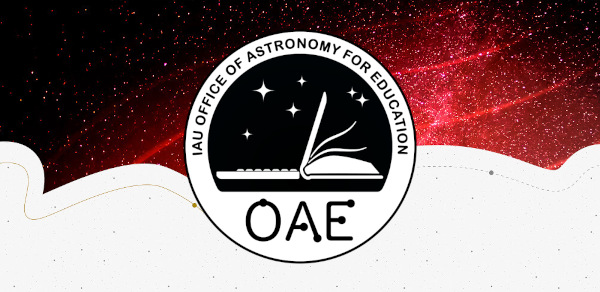Loading...
Related Media
Till the End of the World, by Hang Li, China
Caption: First place in the 2021 IAU OAE Astrophotography Contest, category Aurorae (time-lapses).
Aurorae are often called "Northern Lights" in Europe or North America but here we see that they also exist at the extreme south of our planet. Taken at Zhongshan Station, Antarctica, this time-lapse (speeded up) video shows how some bands of Aurora can remain stable over longer times while other features appear to "dance". See how many different patterns of swirls and waves you can spot in the video.
Credit: Hang Li/IAU OAE
Credit: Hang Li/IAU OAE
License: CC-BY-4.0 Creative Commons نَسب المُصنَّف 4.0 دولي (CC BY 4.0) icons
Icelandic Rivers of Light, by Sergio Díaz Ruiz, Spain
Caption: Second place in the 2021 IAU OAE Astrophotography Contest, category Aurorae (time-lapses)
This video shows how aurorae evolve slowly over timescales of a few minutes. Note the clouds being illuminated from behind in the last two shots. Aurorae are caused by interactions between the charged particles blown out in huge explosions from the Sun and the Earth's magnetic field. The changes over time are caused by huge waves of particles pushing the Earth's magnetic field into strange shapes before it snaps back into place.
Credit: Sergio Díaz Ruiz/IAU OAE
Credit: Sergio Díaz Ruiz/IAU OAE
License: CC-BY-4.0 Creative Commons نَسب المُصنَّف 4.0 دولي (CC BY 4.0) icons
Multicolored aurora in Iceland, by Marco Migliardi on behalf of Associazione Astronomica Cortina, Italy
Caption: First place in the 2021 IAU OAE Astrophotography Contest, category Aurorae (still images)
Aurorae are the result of ionisation and excitation processes in Earth's upper atmosphere, caused by charged particles from the solar wind or from coronal mass ejections. The different colours in an aurora display indicate the species of atmospheric atoms and molecules involved. The most common colour is a bright green, which, together with deep red, originates from atomic oxygen. Blue, purple and pink hues are much rarer and originate from molecular nitrogen. The reflection of the aurora in the water indicates the brightness of intense aurorae at higher latitudes.
Credit: Marco Migliardi on behalf of Associazione Astronomica Cortina/IAU OAE.
Credit: Marco Migliardi on behalf of Associazione Astronomica Cortina/IAU OAE.
License: CC-BY-4.0 Creative Commons نَسب المُصنَّف 4.0 دولي (CC BY 4.0) icons
Northern Lights - Teepees
Caption: Taken with a smartphone at Cassidy Point, Yellowknife, Canada, on 24 March 2023, this stunning display captured the ethereal Northern Lights painting the night sky. The biting cold of -20°F (-29°C) set the stage for the vibrant hues of the Aurora Borealis, a celestial ballet created by collisions between charged solar particles and the Earth's atmosphere. The Earth’s magnetic field directs the charged particles towards the polar regions, where they interact with the various atoms and molecules in the atmosphere. This natural phenomenon transforms the sky into a canvas of radiant greens, pinks, and purples, casting a mesmerising glow above. The different colours of an aurora are determined by the gases in Earth’s atmosphere, the altitude where the aurora occurs, the density of the atmosphere, and the energy of the charged particles. In general, green is attributed to oxygen molecules, red is associated with high-altitude oxygen molecules, purple and blue are associated with hydrogen and helium, and pink aurorae are typically associated with nitrogen. Against this cosmic backdrop, the teepees of Aurora Village below provide a tranquil contrast to the celestial spectacle unfolding overhead. Preserving the pristine darkness of this location ensures the continued splendour of such awe-inspiring natural light shows.
Credit: Oanh Vuong/IAU OAE (CC BY 4.0)
Credit: Oanh Vuong/IAU OAE (CC BY 4.0)
License: CC-BY-4.0 Creative Commons نَسب المُصنَّف 4.0 دولي (CC BY 4.0) icons
The Big Dipper in the Polar Night
Caption: Step into the cosmic theatre of Iceland’s northern skies in this time-lapse where the illustrious Big Dipper commands attention, tracing an almost complete circle around Polaris — an exquisite sight that is not visible from mid-latitudes. This time-lapse, captured through fisheye lenses, reveals the timeless choreography of the Big Dipper, vividly illustrating its celestial waltz. Amidst this spectacle, the Arctic night reveals its grandeur, painting a panoramic canvas that showcases not just the celestial journey of this iconic asterism but also the ethereal dance of the Northern Lights. In this breathtaking tapestry, the Big Dipper takes centre stage against the mesmerising backdrop of the Icelandic nightscape, adorned by the vibrant hues of the Aurora Borealis.
Credit: Stephanie Ziyi Ye/IAU OAE (CC BY 4.0)
Credit: Stephanie Ziyi Ye/IAU OAE (CC BY 4.0)
License: CC-BY-4.0 Creative Commons نَسب المُصنَّف 4.0 دولي (CC BY 4.0) icons
Fire of the Sky
Caption: In the serene landscapes of Lofoten, Norway on 28 March 2023, the sky was set ablaze by the aurora. The Northern (Southern) Lights, also known as aurorae, are natural light displays resulting from interactions between solar winds and Earth’s magnetic fields, as charged particles are redirected towards the north and south pole regions. In Norse legends, they are often depicted as a heavenly fire. In this scene, the celestial show is beautifully complemented by the silhouette of a lighthouse, as if the lighthouse ignited the mesmerising display overhead. Caught off-guard by this dazzling spectacle, the photographer swiftly captured the moment with a smartphone. This is a testament to the breathtaking surprises nature offers and the impressive capabilities of modern devices.
Credit: Stephanie Ziyi Ye/IAU OAE (CC BY 4.0)
Credit: Stephanie Ziyi Ye/IAU OAE (CC BY 4.0)
License: CC-BY-4.0 Creative Commons نَسب المُصنَّف 4.0 دولي (CC BY 4.0) icons
Northern Lights Color
Caption: This photograph taken with a smartphone captures the ethereal beauty of the Northern Lights at Cassidy Point, Yellowknife, NT, Canada on 24 March 2023, at temperatures well below freezing (–29°C). The mesmerising dance of the Aurora Borealis (Australis), commonly known as the Northern (Southern) Lights, paints the night sky in striking hues. The aurora is a natural phenomenon caused by charged particles from the Sun interacting with Earth’s atmosphere, and being redirected by Earth’s magnetic field towards the north and south polar regions. The charged particles excite atoms and molecules in the atmosphere, resulting in a light display that varies in colour and form. The different colours of an aurora are determined by the gases (atoms and molecules) in Earth's atmosphere, the altitude of the aurora, the density of the atmosphere, and the energy of the charged particles. In general, green is attributed to oxygen molecules, red is associated with high-altitude oxygen molecules, purple and blue are associated with hydrogen and helium, and pink auroras are typically associated with nitrogen. On this particular night, the serene environment of Cassidy Point provided an unobstructed view of the lights. In the foreground, Aurora Village can be seen, a site renowned for organised tours to witness this spectacle.
Credit: Jason Johnson/IAU OAE (CC BY 4.0)
Credit: Jason Johnson/IAU OAE (CC BY 4.0)
License: CC-BY-4.0 Creative Commons نَسب المُصنَّف 4.0 دولي (CC BY 4.0) icons
